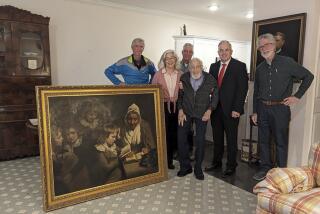Van Gogh’s ‘Sunset at Montmajour’ unearthed; how good is it?
- Share via
The news Monday of a lost but rediscovered painting by Vincent van Gogh has everything art needs to become a big media story: major celebrity, fooled experts, lottery-scale riches and a back-story worthy of “Antiques Roadshow.”
A canvas by one of the world’s most famous artists got dismissed as a fake, tucked away for decades, forgotten in an attic, brought out for reevaluation and, after two years of scrutiny, declared to be the genuine article. It’s a rags-to-riches tale.
Just about the only thing the story doesn’t have – only because it doesn’t need it – is a very great work of art.
PHOTOS: ‘Sunset at Montmajour’ and other Van Gogh paintings
Of course I’ve only seen the 1888 painting in photographs, where it appears to be blandly pretty. And any addition to Van Gogh’s remarkable legacy is worthwhile, since it tells us a bit more about his working life.
It’s also useful to be reminded that even the greatest artist doesn’t always perform at his peak.
Using a reed pen and black and brown ink, Van Gogh did make some fantastic drawings of olive trees, rock formations and the fields around the ruined Benedictine monastery at Montmajour shown in the painting’s upper-left corner. But, in general, the landscapes he painted that summer in southern France in and around the town of Arles pale in comparison to the magnificent portraits and interiors he made. Perhaps it’s because drawings, like portraits and interiors, convey an immediate intimacy missing from the scrubby field and roiled sky in the newly anointed “Sunset at Montmajour.”
STORY: Chasing the White House Cézannes
I’m also happy to defer to the artist, who seems to have been less than thrilled with the results himself. According to reports, researchers at Amsterdam’s Van Gogh Museum say that a July 5 letter to his brother Theo refers to the painting:
“Yesterday, at sunset, I was on a stony heath where very small, twisted oaks grow, in the background a ruin on the hill, and wheat fields in the valley. It was romantic, it couldn’t be more so, à la [Adolphe Joseph Thomas] Monticelli, the sun was pouring its very yellow rays over the bushes and the ground, absolutely a shower of gold. And all the lines were beautiful, the whole scene had a charming nobility. You wouldn’t have been at all surprised to see knights and ladies suddenly appear, returning from hunting with hawks, or to hear the voice of an old Provençal troubadour. The fields seemed purple, the distances blue. And I brought back a study of it too, but it was well below what I’d wished to do.”
Oddly, this letter has long been thought to refer to a different painting -- “Rocks with Oak Tree,” another unsigned work that’s in the collection of the Museum of Fine Arts Houston. Until now, that was believed to be Van Gogh’s only painting of the immediate environs of Montmajour. He made a drawing of the Houston picture several weeks later, which he sent to his painter-friend Emile Bernard – an indication that he found the painting to be successful.
Perhaps the letter refers to both works. (One researcher on the new discovery told the Associated Press that “it belongs to a special group of experimental works that Van Gogh at times esteemed of lesser value than we tend to nowadays.”) Whatever the case, the entire letter can be found in the indispensable edition of Van Gogh’s correspondence published online in 2009.
ALSO:
Israel Museum gets 74 Richard Avedon photographs
Artifacts continue the 9/11 narrative in a new book
‘Newsroom’s’ Alison Pill to star in ‘Wait Until Dark’ at the Geffen
More to Read
The biggest entertainment stories
Get our big stories about Hollywood, film, television, music, arts, culture and more right in your inbox as soon as they publish.
You may occasionally receive promotional content from the Los Angeles Times.











